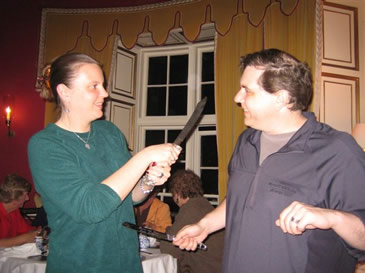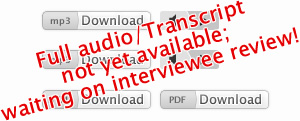
Brad Geddes, who used to be with Local Launch, is the smartest guy I know when it comes to pay per click marketing. Brad has managed campaigns with so many keywords in them that they have 6 adwords accounts linked together – we’re talking 2.3 MILLION keywords! He’s also managed to generate consistently 18% clickthroughs from some of his campaigns. There are so many guys out there teaching and running pay per click programs. But Brad is among the best, and he’s been doing a bunch of training for Google in adwords as well. He was known on webmaster world as ewhisper for many years.
Full Interview Audio and Transcript
Personal Info
Hobbies and Interests: Kayaking, travelling, camping.
Favourite Sports Teams: Pittsburgh Steelers, Penn State Nittany Lions.
Favourite Books:
- The Wisdom of Crowds by James Surowiecki.
Favourite Entrepreneurs: Justin Sanger (Local Launch), Perry Evans (founder of MapQuest).
Personal blog: http://bgtheory.com/blog
Company Website: http://www.bgtheory.com
Fast Track Interview
Adrian Bye: I’m here with my friend, Brad Geddes, who used to be at Local Launch. He is now launching his own private company around Pay per click (PPC) called bg Theory. Brad, tell us a little bit about your background and what you’ve been doing up until now.
Brad Geddes: Sure, I started in Internet marketing about a decade ago. I consulted for a number of years on usability, SEO, PPC, media buys, and integrated marketing sales force. In 2004, I joined Local Launch. At first, I ran the Professional Services Division, which again was PPC, SEO, and media buys.
We then started productizing so we could empower other newspapers and yellow page companies that had a sales force but didn’t have digital or interactive marketing. We made an entire platform and created products that had simplified sales pitches and good ROI for the advertiser. We built a system where we could create an effective PPC account with thousands of keywords and hundreds of ad copies in a matter of minutes.
When I left Local Launch in July 2008 to start a new company, I sat back and thought, “What do I want to do?” I love watching a small business or a public company try something new and get the input, the skills, and the technology they need. I want to empower these companies to succeed. If it is a small company that doesn’t have the revenue to pay for a lot of expensive in-house consulting, we can put on seminars. If it’s a large public company with an entire in-house marketing team, we work closely to train other individuals on PPC, SEO, social media, or even usability.
Adrian Bye: Can you take us through the entire process for a Pay per click campaign?
 Brad Geddes: The first thing you need to do is examine the search process you’re trying to fit your marketing into. For example, someone has an idea or something they’re thinking about; they want to find the cheapest computer or the best new LCD monitor. They go to Google and convert their idea into words they type in, and then the ads come up. Right away, the ad has to be synergistic to what the consumers are looking for in their idea. Having a close match between the ad and the idea is important, and ad copy serves as the bridge. That is what entices someone to view your site, which then gives them information, converts them, or whatever actions and goals they are looking for.
Brad Geddes: The first thing you need to do is examine the search process you’re trying to fit your marketing into. For example, someone has an idea or something they’re thinking about; they want to find the cheapest computer or the best new LCD monitor. They go to Google and convert their idea into words they type in, and then the ads come up. Right away, the ad has to be synergistic to what the consumers are looking for in their idea. Having a close match between the ad and the idea is important, and ad copy serves as the bridge. That is what entices someone to view your site, which then gives them information, converts them, or whatever actions and goals they are looking for.
Your keyword research and ad copyrighting need to be tightly formed together. It’s common to see an ad group with 2,000 unrelated keywords within a single ad copy. From a consumer standpoint, those two aren’t closely related. You can’t have keywords that mean nothing to the consumer who just did his search. The biggest thing is to break those keyword standards on very tight groups.
Adrian Bye: Are you manually or automatically auto-inserting keywords and page text to make pages more relevant? How do you do that efficiently?
Brad Geddes: From a keyword standpoint, you could use a source such as Speed PPC to build this keyword list pretty fast. However, you still want a human eye to take a quick look at it to make sure it all makes sense together. Once you have those tightly formed ad groups and have ad copy that completely reflects that, it’s easy.
It’s probably most scalable to use some sort of automation when creating an account with hundreds of thousands or millions of keywords whether it’s in a toolset, using Excel, or building a tool that looks at the keywords and your ad copy. Then it’ll write some more formulated-based ads.
This next step in the campaign process is asking, “What’s the return we’re getting by ad copy and by keyword?” You want to combine this with doing some ad copy testing. Write a few ads and look at what’s working. It is also just as important to know why it’s not working. If the keywords aren’t working, it’s not that you should delete them but rather it is asking, “Is there a reason it’s not working? Is it that this ad isn’t right? Is it that the landing page isn’t right?” Asking these questions and making sure of certain things gives the keywords a second chance. You can verify whether it really cannot convert or if it was just a flaw in the setup.
You also want to determine your goals for the campaign. If you’re a publisher selling CPM ads, your goal is probably to maximize traffic at certain revenue per visitor. Other e-commerce companies want to get 200 percent ROI. Without a goal in mind, you do not have a way of making changes to meet that goal.
Once you list those goals, you’re going to look at your metrics to measure those goals. You’re going to run a report that looks at what is and isn’t converting and how much everything is costing you compared to its goal size. Those reports can be run within the AdWords interface or another system you’re using if you built an API on top of it.
Once you can see those metrics, it becomes pretty easy to start tweaking. For example, this is working and we get fantastic returns here, or we’re only in position three or four, let’s move that up a bit, or these words aren’t working for us but they’re high volume words; I really like them, so let’s create a special landing page for this set of words to see if we can make them convert.
 It is looking at your metrics and making decisions. If you’re not making decisions on your metrics, you’re not doing anything. You are simply looking at metrics, which doesn’t get you anywhere. Once you get to the point where you can look at your ROI per keyword or how much you’re making then every time someone does a search, you can look at that by keyword and ad copy and see all the intersections. Then you can make some really solid decisions about how to change your bids, remove bad copies completely, change new paths, or work on your landing page. It becomes a circular process.
It is looking at your metrics and making decisions. If you’re not making decisions on your metrics, you’re not doing anything. You are simply looking at metrics, which doesn’t get you anywhere. Once you get to the point where you can look at your ROI per keyword or how much you’re making then every time someone does a search, you can look at that by keyword and ad copy and see all the intersections. Then you can make some really solid decisions about how to change your bids, remove bad copies completely, change new paths, or work on your landing page. It becomes a circular process.
One other thing, you need to keep on top of the jargon and new keywords developing in your industry and what people are searching for; then continue to refine those keyword sets. For example, in the medical industry, something new is always coming out. In other industries such as real estate, there is not a new keyword at all. It makes sense to look in your industry, understand how fast or slow it moves, and what can be done from a conversion standpoint to bring that whole cycle together.
Adrian Bye: How do you take this to your SEO site once you’ve done this through a couple of cycles?
Brad Geddes: Once you have done this a few times, you understand what words convert the best. That is where you are going to start your SEO: what words have the highest volume that you can’t make perform on PPC. Some words might have so much volume with them that you get some conversions but you can’t keep paying those conversions. With the higher search volume comes higher competitive keywords, but in that case you want to put those in your SEO effort because SEO is “free” once it’s done. It takes time, so you have to determine how much time your SEO’s costing you. You probably even want to take your highest converting words and highest volume words and start your SEO from there.
Then the same goes for looking at SEO. If you have words converting extremely high in SEO that may not even be in your Pay per click campaign, you would want to switch those around. There is definitely an incremental value of being in the top positions unpaid and the top positions on the SEO, which is the natural, organic side. The consumers having a higher confidence of seeing your site listed twice.
Adrian Bye: Can you explain some of the more sophisticated tricks and things happening in the Pay per click world?
Brad Geddes: The biggest issue people are having is the ubiquitous quality score. Let me explain. When you think of your placement and your Pay per click campaign, it’s a pretty simple formula. It is the maximum cost you are willing to pay times your quality score factor. This determines where you’re going to show up on a page. If you have a really high-quality score you could essentially bid a lot less and appear higher than your competition. The problem with quality score is it continues to get more sophisticated by using multiple factors.
Basically from a search engine’s standpoint, quality score is their measure of relevance. For a moment, put yourself in a search engine’s shoes. Someone comes to your site and does a search. The search engine’s job is to send them away from their property, which is opposite of every other site’s job. Every other site wants to keep them in their property. The goal of the search engine is repeat visitors. In other words, they want someone to find what they’re looking for so they will return and do another search.
Essentially, relevancy is what keeps someone returning to a particular search engine. They want to make sure they’re giving their consumers, people who search their site, the best possible results from a paid and a free, organic standpoint.
Adrian Bye: How do they define relevancy? Is this something that’s done by hand or with technology?
 Brad Geddes: Obviously some hand reviews occur. However for the most part it is done with technology. They take their spider and look at a page and the overall site. They ask, “What’s the relationship between the keyword search queries.” Of course, when someone does a search query on Google, Google knows what they search for. If they turn around and search for something else right next to it, they probably know those two terms are related. They could then search the database to understand how all of these different keywords are actually related.
Brad Geddes: Obviously some hand reviews occur. However for the most part it is done with technology. They take their spider and look at a page and the overall site. They ask, “What’s the relationship between the keyword search queries.” Of course, when someone does a search query on Google, Google knows what they search for. If they turn around and search for something else right next to it, they probably know those two terms are related. They could then search the database to understand how all of these different keywords are actually related.
Adrian Bye: What are some other techniques to guarantee you have a high-quality score?
Brad Geddes: The most important things with quality score are the keyword, the ad copy, and the landing page. Those three things are very closely related. Landing page load time is now used because in a high broadband world where everything moves fast, we want information quickly. Clickthrough rate is also used in quality scores.
There are certain times when Google is famous for other relevancy factors. Some of that goes to local search queries. For example, if you do a search for a New York dentist, they are going to look at an individual’s campaign asking, “Is this person geographically targeting just New York or are they targeting the entire United States?” It is probably not quite as relevant to target the whole United States as someone who is just targeting New York for their query. Geographic targeting is another good way of becoming more relevant, especially if you have a landing page that has a New York dentist in that instance.
The last one is they have their minimum bids right now. Minimum bids are tougher to deal with because some people can see it when you log in to your Ads account. Let’s say you have a minimum bid of one dollar. Some people consider that to be bid guidance. It’s like Google is saying, you bid a dollar. Really, that’s the lowest you can bid and have a chance to appear in search. That’s one way for those looking at your keywords and at minimum bids to see how relevant you are. If you have a minimum bid of a dollar, obviously you are not that relevant. That’s another quick way to look at how relevant my keywords are because Google thinks they are.
Another way that is very useful is in Google’s keyword toolset. You can have them spider a Web page to tell you what they think the keywords are on that page. You can place your URL in the List URLs page, hit submit, and Google will crawl that page to find what is relevant.
It will say, “We think this page is about these keywords.” If those keywords are exactly opposite of what your keywords really are, you have a problem. If they’re all relevant, then you’re in good shape. It’s also a good way to research your competitors. Put in your competitor’s URL, and see what Google thinks those pages are about; then you can see how relevant you are opposed to them.
Another big thing is if you can connect consumers to the local area. Everyone is very tied to where they live. If you live in New York and talk bad about the Yankees, you’re going to get stared at. If you go to Chicago and talk good about the Bears, the people are going to like it more. They identify a lot with geographic areas.
You can put information about geography in the ad copy. For example the phrase “located in the Triangle” means nothing to most people, but it’s really talking about downtown Pittsburgh. Consumers connect to it immediately because you are using their local language. In any campaign, regardless of topic, using some of that local information ties the consumers right to the ad copy.
With the web, we tend to forget people still search by physical location; they still live somewhere. They are searching at a certain time of day; they are searching in a certain city, even a certain country. Think past the Web to the physical person you are trying to connect to. What other factors are going on there? Put that in your ad copy or in your landing page and you’ve really drawn someone into your marketing. You could often use some very interesting things and see some much higher conversion and clickthrough rates.
Adrian Bye: Is there anything we haven’t talked about that you’d like to mention?
Brad Geddes: When you think about digital marketing, the most important thing is to think about the consumer. How do they search? How do they shop? Once you understand your customers, you can determine how the Web site and marketing should lay out. A marketing plan is looking at the entire sales cycle and understanding how to make sure each part of the sales cycle reaches a consumer in the way they want to be reached.










